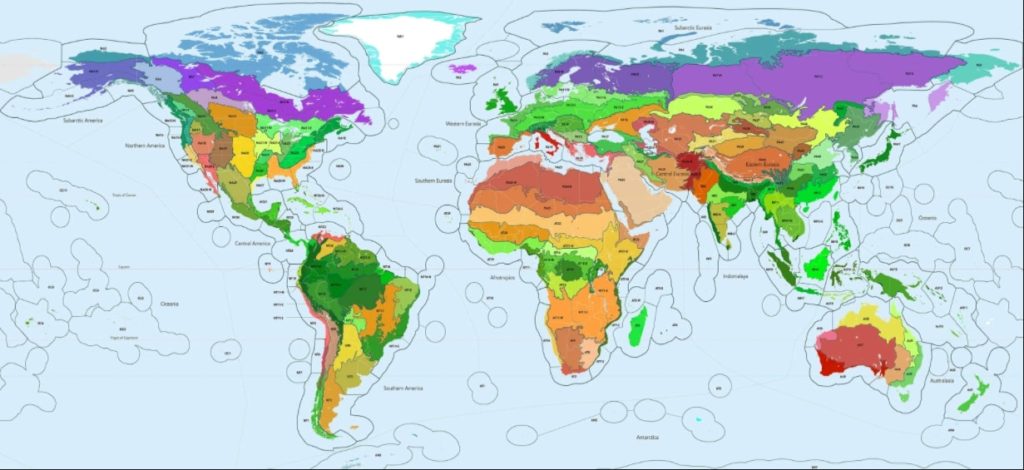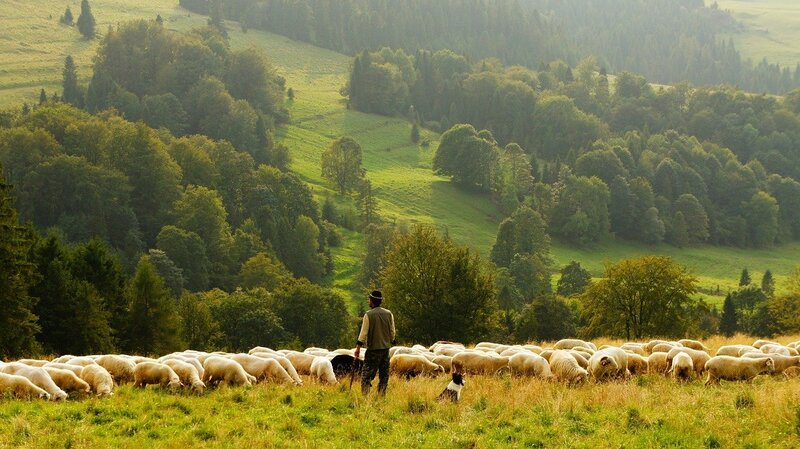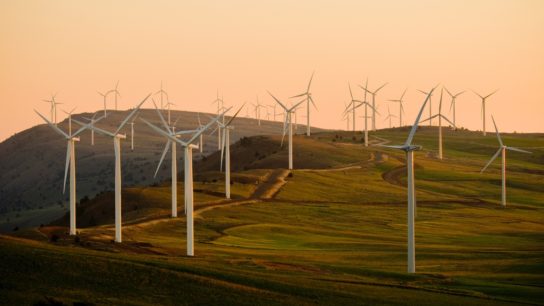The current world order is woefully inadequate at protecting natural habitats and preserving ecological services and resources for future generations and other species. Our planet is delineated by nation-states largely bound by construed borders, and is characterised by a predominantly capitalist mindset which thrives on wealth accumulation. The idea of a green post-capitalist order, where resource scarcity and competition are non-factors, is often dismissed as an idealistic and unachievable dream. However, while largely theoretical and untested, the ideas behind such an order are rooted in a decidedly realistic and scientific approach to governance. Bioregionalism is one such approach, illustrating a possible future wherein our models of economic and social governance are more localised, democratic and self-sustaining.
—
International supply chains, globalised markets and specialisation in specific geographic areas to serve the global economy are hallmarks of the neoliberal approach to economics. This approach has certainly made life more comfortable for many, who benefit from easy access to goods and services that can be sourced from all over the world at virtually a moment’s notice.
This system also has clear drawbacks and very tangible failures, mostly tied to overexploitation in resource-rich developing countries and an overreliance on international supply chains to maintain even the most basic living standards. The more interconnected and complex our world has become, the more fragile and vulnerable to unforeseeable disruption our systems and institutions are.
For instance, because our global energy supply remains largely dependent on fossil fuels, nations that are unable to source hydrocarbons in their own territories are reliant on the few fossil fuel producer countries for all their energy needs. Reliance on international supply chains is dangerous because they can be easily disrupted due to unstable maritime shipping conditions or unilateral trade restrictions. Dramatic price shocks can also occur because of conflict in producer countries, as happened following a drone and missile attack targeted at a Saudi oil facility in March 2021.
These disruptions are often unpredictable and carry many adverse side-effects, even for parties not involved in the event that caused the disruption in the first place. In a globalised and interconnected economy, a single change or event somewhere in the world has the potential to cause shortages and market failures across the planet, damaging social conditions, living standards and incomes.
The failures of a globalised economy are compounded by its environmental impact, fuelled by an emphasis on overconsumption, trade and overexploitation of natural capital. In 2018, the World Trade Organization estimated that the total value of exports from developing countries was around USD$8.8 trillion, of which $193 billion was from least-developed countries. Much of these exports were fuel and mining products, manufactured goods and food.
Consumers in wealthier countries have become accustomed to this ease of movement that allows goods produced or grown overseas to be sold in local supermarkets. These comforts come at a price, however. About one quarter of global emissions are due to the production and distribution of traded goods and services. 15% of trade-related emissions is generated in the US, the largest consumer market in the world.
You might also like: Bill Gates-Backed Startup Aims to Make Green Hydrogen Cheaper

Figure 1: 2015 CO2 emissions related to trade by country; Banque de France; 2020.
Despite the improved standards of living and the indulgences that the global trade network affords us, the environmental costs are high, not to mention the social and ethical ramifications of exploiting the natural and human capital of developing countries to satisfy consumer demand in the Global North. In Tanzania, for instance, in order to satisfy export quotas for fish to be sold in Europe, officials have allowed overfishing to occur quite freely. In addition to the environmental damages caused by overfishing, the massive exportation of food is occurring against the backdrop of a local population grappling with food insecurity.
Bioregionalism is a framework that attempts to address the contradictions and failures of the global market economy, by focusing on what countries need to become more self-sufficient and valorising locally sourced goods and services.
The Bioregional View
At its core, bioregionalism aims to address the inequitable distribution of resources and the disproportionate strain that current economic models places on natural environments and local people. American environmental writer Peter Berg popularised the ideology, emphasising a social structure where community ties were strengthened, awareness of natural resources enhanced and dedication to environmental conservation imprinted upon the public.
In the bioregional view, such a society could be achieved by grouping populations in accordance to bioregions. Ecologically speaking, a bioregion is a specific geographic area that is distinct from others by the characteristics of its natural environment. A bioregion is larger than an ecosystem, and is in fact usually host to several. A bioregion is large enough to encompass all the biological activity and ecological processes necessary for life to sustain itself, and for local habitats and ecosystems to preserve their biological integrity. Bioregions are often used by environmental organisations and government departments to plan and map biodiversity conservation efforts. They are certainly influenced by administrative and political boundaries, but are neither defined nor constrained by them.

Figure 2: Bioregional map based on biome and geological distinctions; One Earth; 2020.
The bioregional movement expands upon the scientific classification of bioregions, primarily by incorporating a cultural element. Bioregionalism considers bioregions to be defined by the people that inhabit them, who share a unique cultural identity and consider themselves equally at home within the bioregion. Commonalities in cultural identification is a critical component to the bioregional perspective, because a major focus of the movement is to empower residents to actively and democratically participate in the protection of their shared resources and native land.
While a single bioregion may include numerous different habitats and ecosystems, bioregionalism emphasises that each place is profoundly interconnected with one another. A good example of this is a region’s watershed or drainage basin, an area of land where all precipitation collects into a single waterway or set of waterways, and drains into a common outlet. When circumstances change upstream closer to where precipitation falls or ice peaks melt, they can affect critical water supply for downstream habitats. The localised interconnectedness in bioregionalism is meant to create a sense of awareness of natural resources and domino effects, and ultimately to foster interest and care for nature amongst the bioregion’s residents, who are incentivised to place higher value on local natural capital.
Berg and notable biologist Raymond Dasmann described their shared view of bioregionalism in the following ways:
“A bioregion can be determined initially by use of climatology, physiography, animal and plant geography, natural history and other descriptive natural sciences. The final boundaries of a bioregion, however, are best described by the people who have lived within it, through human recognition of the realities of living-in-place.” The pair also described bioregions as “[referring] both to geographical terrain and a terrain of consciousness, to a place and the ideas that have developed about how to live in that place.”
By valorising nature and elevating the cultural component to bioregions, bioregionalism attempts to describe an economic and governance model that is based on community, attachment to land and a sustainable relationship between man and nature. Bioregionalism emphasises that this sense of community and shared culture stems from the local geography and ecological traits of the bioregion, which are ultimately what bind the society together.
Direct Democracy Through Bioregionalism
A 2017 paper by researchers at Roehampton University in the UK evaluated the potential functionality of a bioregional economy. The authors specifically analysed the potential for such a framework to improve democratic functioning within societies by encouraging self-sufficiency and shifting public interest towards biodiversity conservation and sustainable use of resources.
The foundation of a bioregional society is to be economically self-sufficient, and reliant only on what it itself can produce. Our current economic model is much the opposite, built upon global commercial relations and supply chains. While bioregionalism allows for some international trade to occur when local needs cannot be met due to specific climate, geographical and environmental circumstances, any reliance on it is unsustainable. This is because consumers rarely feel a personal link between the goods and services they purchase and the resources that were extracted to produce them.
This can easily lead to careless resource depletion, environmental degradation and poor governance, but can also create a system of power where agenda-setting and decision-making becomes highly centralised into the hands of the few individuals in business and politics upon which stable supply chains are reliant. By creating a self-sufficient economy, bioregionalism shifts those priorities and decentralises political power. In theory, a bioregional economy would grant citizens more authority and incentive to not deplete their land.
This would be a more direct form of democracy than exists today, wherein citizens participate more collectively in local decisions on how and where to distribute resources within their bioregion. In a bioregional economy, a population is dependent on domestic workers to produce enough commodities for the community to survive, and so workers are considered crucial to socio-economic development. The voices of primary environmental stewards, including workers and all domestic producers, are therefore given more agency and authority in decision-making processes by including them in expanded legislative councils and by having the public directly involved in writing constitutions. In theory, a bioregional economy would make sustainable extraction, environmental stewardship and conservation more popular public concerns. In this localised system, individuals would also be more concerned about whether the land will be able to support their offspring and future generations.
The bioregional economy framework also calls for higher degrees of cooperation between communities residing in the same bioregion, since the ability of each ecosystem to provide is dependent on the stability of others. Communities would therefore be incentivised to self-regulate their actions, and communicate information with others regarding failures and successes.
Bioregionalism argues that this strengthened solidarity will naturally emerge from implementing a governance framework based on bioregions, that gives citizens and residents more agency in decision-making. It is local empowerment, rather than subservience to global forces beyond their control, that enables bioregional communities to engage in genuine acts of solidarity, which will ultimately extend to cross-bioregional communications.
The theory of bioregionalism is one that is closely linked to the emerging concept of eco-localisation. This is the notion that localisation of economic productivity can be directly correlated to positive sustainable development and environmental conservation outcomes. A 2018 study in Bhutan found that, on a regional level, where localisation increased so too did sustainability. While the same correlation was not necessarily found at a national level, this was mainly attributed to a lack of national indexes or metrics that could adequately evaluate the impact of economic activities on sustainability. The study concluded that localisation of economic activity, as opposed to globalisation strategies, should be considered a crucial ingredient to sustainability planning.
The bioregional approach expands upon the notion of eco-localisation, addressing self-sufficiency and direct democracy, while ensuring better stewardship of natural capital and creating stronger bonds between humans and nature. While it remains purely theoretical, bioregionalism provides a framework that indicates a pathway and desirable outcomes for a post-capitalist economic model. The 2017 paper emphasises that a bioregional alternative would not necessarily forgo markets or international trade, but would make localisation a core tenet to the governance and economic framework of society nonetheless, where local people would be the prioritised recipients of benefits from local resources.
From Theory to Practice
A bioregional framework is certainly difficult to imagine implementing globally, or even nationally. At smaller scales, however, the practices and notions of bioregionalism can be seen in the ideological goals of localised self-sufficient producers and even in some semi-independence movements.
Bioregionalism can be seen in sustainable land management practices such as regenerative agriculture and permaculture. Its ideologies are also manifested in worker and consumer cooperatives, community development finance and ecovillages.
Self-sufficient transition towns may be the best small-scale example of how bioregional ideas are being expressed. These are communities which have made the collective decision to independently wean themselves off fossil fuels and protect themselves from climate change impacts by actively working towards achieving self-sufficiency. Transition towns believe that localising production and energy needs, as well as maintaining strong communal ties, can help them weather future energy shortages and shocks.
The first official transition towns emerged in the UK in 2006, and have since spread across Europe, North America and Australia. Vibrant examples of these towns include Totnes in the UK and Adelaide Hills in Australia, although between 2 000 and 3 000 transition towns are believed to exist worldwide. In addition, over 1 000 burgeoning transition initiatives currently exist worldwide.
Small-scale developments such as transition towns are important because they improve community resilience and show that self-sustaining models of governance are possible when a collective decision is made to depend on local resources. At larger scales, however, a systemic reliance on global markets makes such developments harder to conceive of.
Attempts have been made to create large bioregional movements. In these cases, a strong nationalist or regionalist shared identity becomes the critical factor in determining whether these movements are popular or not, and the bioregionalism factor is often mixed with a movement advocating for secession or independence, borne from regional grievances towards a larger governing entity. An example of this is the Cascadian secessionist movement, an independence movement founded on bioregional ethics and politics of shared identity in Cascadia, a bioregion extending across Southwestern Canada and the Northwestern US.

Figure 3: Map of Cascadia bioregion extending across US-Canada border; US National Atlas Equal Area Sources: Commission for Environmental Cooperation; 2020.
Support for Cascadian independence has swelled in recent years, and the aspiring nation was highlighted by Time in 2011 as a hypothetical country that would “likely prosper” given it was “abundant in both natural and industrial resources and home to giant corporations like Microsoft, Amazon, Starbucks and Nike.” Cascadia could also theoretically become energy self-sufficient, given the region’s potential for hydroelectric and wind power.
While an independent Cascadia could well be a prosperous nation, it is unclear whether it would actually promote better environmental stewardship than national governments. Entrusting domestic workers and individuals with higher degrees of decision-making power is a core tenet of bioregionalism, but whether this would actually translate to better conservation measures remains mostly hypothetical.
There has been one instance, however, where directly involving citizens in the legislative process resulted in more stringent environmental policy and an equitable distribution of dividends from local resources. As most of the world’s democracies appear to tumble towards technocratic governments, Iceland has been taking a different approach. For years, the country has been grappling with attempts to crowdsource a new constitution. In 2011, a legal document was drafted with direct input from citizens, who participated online and through social media to voice public concerns and priorities.
A 2017 study showed that many of the opinions and proposals voiced by the public had a tangible impact on the constitution’s drafting, and were reflected in its final form. While the document has encountered some resistance passing into law, it now appears to be on its way through Iceland’s parliament. The new constitution focuses on environmental preservation, human rights and redistribution of dividends from the country’s natural resources, particularly from fishing. While it may not necessarily be bioregionalism, the Icelandic constitutional experiment largely achieved the same outcomes: a legal document that affects how the country governs received substantial input from its citizens, and prioritised environmental protection and effective resource distribution.
There are clearly many obstacles to overcome before anything even resembling a bioregional economy could be implemented. What bioregionalism offers is an alternative to our increasingly globalised markets and models of governance. Legislation that is more participatory and personalised can reflect the critical public interests of environmental integrity and sustainable extraction of resources. Localised economies may be better suited to achieving these outcomes, but in lieu of a radical reorganisation of our political boundaries, strengthening institutions, public trust in government and creating a more direct form of democracy can support self-sufficiency and sustainability goals.














